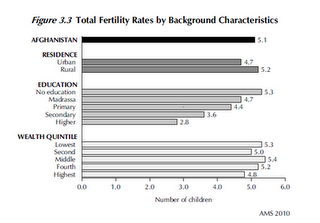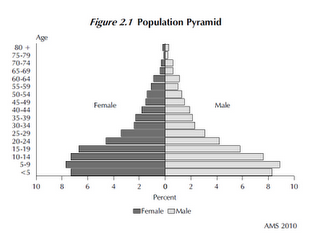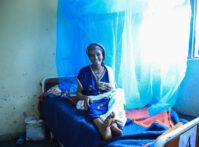-
Afghanistan’s First Demographic and Health Survey Reveals Surprises [Part One]
February 14, 2012 By Elizabeth Leahy Madsen
Late last year, Afghanistan’s first-ever nationally representative survey of demographic and health issues was published, providing estimates of indicators that had previously been modeled or inferred from smaller samples. It shows that Afghan women have an average of five children each, lower than most experts had anticipated, and that their rate of modern contraceptive use is just slightly lower than that of women in neighboring Pakistan.
The Afghanistan Mortality Survey 2010 is based on interviews with nearly 48,000 Afghan women, ages 12 to 49, conducted over eight months in 2010. Due to conditions of extreme insecurity, 13 percent of the population, mostly living in the southern provinces of Helmand, Kandahar, and Zabul, had to be excluded from the survey. Although officially titled a mortality survey, it includes the topics most commonly addressed in other USAID-sponsored Demographic and Health Surveys (DHS), such as fertility, family planning, and maternal health. The survey objectives were to provide a knowledge base of health needs as the country continues to rebuild from constant conflict, as well as to demonstrate how international humanitarian and development investments have affected population well-being.
Afghanistan’s last census was conducted in 1979, the year of the Soviet invasion, which ushered in a decade of war followed by more insecurity. The population then was estimated at 15.6 million; in 2010, the UN Population Division estimated it had reached 31.4 million.
Contraceptive Use Higher Than Sub-Saharan Africa
Fertility in Afghanistan is estimated at an average of 5.1 children per woman. While still quite high – growing at 2.6 percent per year, the population is on pace to double every 26 years – this is significantly lower than estimates generated before the survey was conducted. Afghanistan was often grouped among countries with the highest fertility rates in the world. The most recent fertility estimates from the U.S. Census Bureau, UN Population Division, and Population Reference Bureau range from 5.8 to 6.6 children per woman. Even these estimates are lower than those for the 1990s, when the UN pegged the fertility rate at eight children per woman.
In 2009, demographers Richard Cincotta and Carl Haub noticed indications of demographic change in Afghanistan, with Haub suggesting that the national Basic Package of Health Services, introduced in 2003, was succeeding in bringing health care, including family planning, to rural areas. The Mortality Survey itself proposes that fertility rates may be falling due to urbanization and “exposure to modern means of communication,” as well as access to family planning.
Although women in Afghanistan are often restricted in their mobility outside the home, knowledge of effective family planning methods is, as in most countries, almost universal. However, current use of contraception remains relatively low: One-fifth of married women of reproductive age are using a modern contraceptive method, most commonly injectables or the pill. Following the typical pattern, contraceptive prevalence is higher among women who are educated, wealthier, and those who live in urban areas. Still, family planning use among rural women has more than tripled since 2003 and the overall rate is four points higher than the average for sub-Saharan Africa.
Household Indicators
Women in Afghanistan face conditions of widespread inequity, and this is reflected in the survey results. Seventy-six percent of women surveyed have never been to school, making education for girls and women a clear priority for government intervention. In a positive step, Afghanistan’s 2004 constitution promised that the government will provide them with education.
The median age of marriage is 18, and half of women surveyed gave birth while still teenagers. Age at marriage directly affects fertility patterns, and another sign that fertility is falling is reflected in the fact that age at marriage is rising among younger women.
Two-thirds of births occur at home, the vast majority of these without the assistance of a skilled provider. Still, the survey also reports much lower estimates of maternal mortality than those prepared by international agencies.
The survey also provides a snapshot of the housing circumstances and economic quality of life for Afghans. About 40 percent get their water from unprotected wells, surface water, and other non-improved sources. Households are large, averaging eight people each, and only five percent of homes have their own flush toilet. Nearly 60 percent of the population lives without electricity and in homes with mud or earthen floors. Although only eight percent of the population has a refrigerator, three-quarters have a mobile phone.
Per capita GDP is estimated at less than $600 annually. More than one-third of the population is unemployed, and agriculture remains the primary industry and source of income, even though most of the country’s land is not arable.
Moving Closer to Pakistan
Despite these dire statistics, given the rapid rise in contraceptive use, the health system has clearly succeeded in improving health care access among some Afghan women. For the demographic picture moving forward, the question is whether rapid jumps in contraceptive use will continue. Several developing countries have experienced an initial decline in fertility that has subsequently stalled. These stalls have been linked to slower improvements in female education, infant and child mortality, and contraceptive prevalence, compared to countries that are experiencing steadier fertility declines. Unfortunately, the Afghanistan survey does not include data on women’s and men’s fertility preferences, sources of contraception, and reasons for not using family planning, which would provide clues in planning priorities for future services and outreach.
The most important general finding of the new survey is that Afghanistan is not as much of a demographic outlier as many observers had assumed, given the challenging conditions of geographic remoteness, violence, poverty, and low status of women. While the sustainability of these improvements can’t be taken for granted in such fragile conditions, the public health system in Afghanistan is making strides against the odds and reaching closer to parity with neighboring Pakistan.
Elizabeth Leahy Madsen is a consultant on political demography for the Wilson Center’s Environmental Change and Security Program and senior technical advisor at Futures Group.
Sources: Afghanistan Ministry of Public Health, Bongaarts (2008, 1978), Cincotta (2009), Embassy of Afghanistan, Guttmacher Institute, Haub (2009), International Monetary Fund, MEASURE DHS, Nishtar (2011), Population Action International, Savedoff (2011), Shapiro et al. (2011), UN-OHRLLS, UN Population Division, U.S. Census Bureau, The Washington Post.
Photo Credit: “View inside Afghan Apartment Block,” courtesy of United Nations Photo; charts courtesy of MEASURE DHS.
Correction: In the second paragraph we originally stated that “nine percent of the population, living in the southern provinces of Helmand, Kandahar, and Zabul, had to be excluded from the survey.” However, there were several “enumeration areas” (units selected to be included in the survey sample), constituting another four percent, that were not surveyed during implementation, also primarily due to insecurity. The total non-covered portion of the population, therefore, is 13 percent.
 A Publication of the Stimson Center.
A Publication of the Stimson Center.










